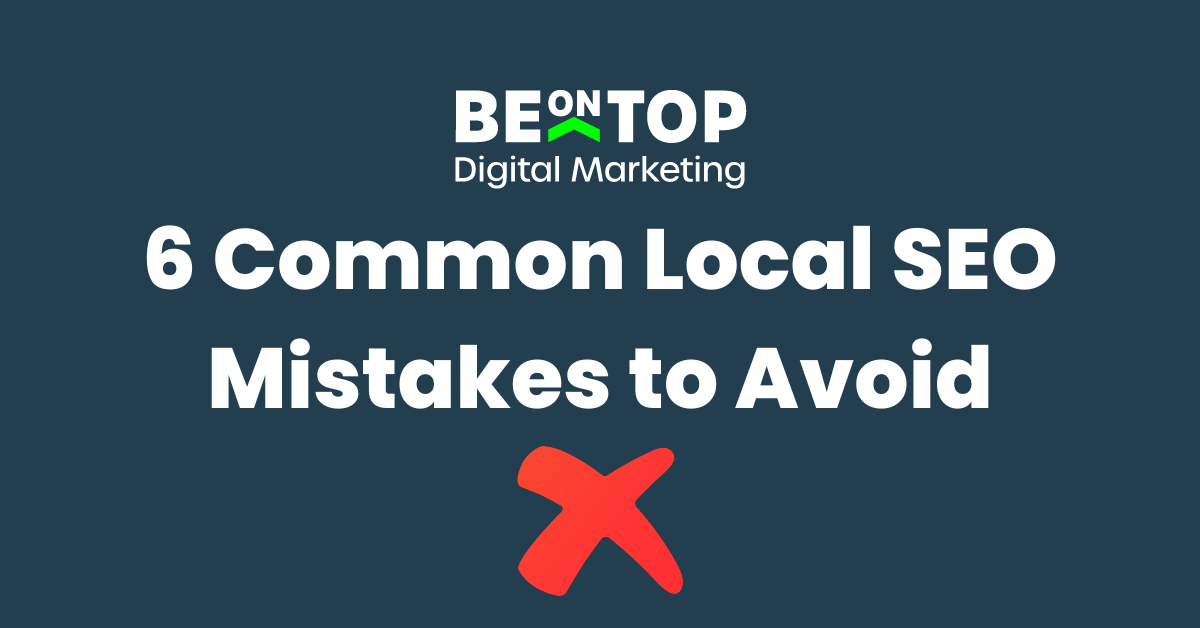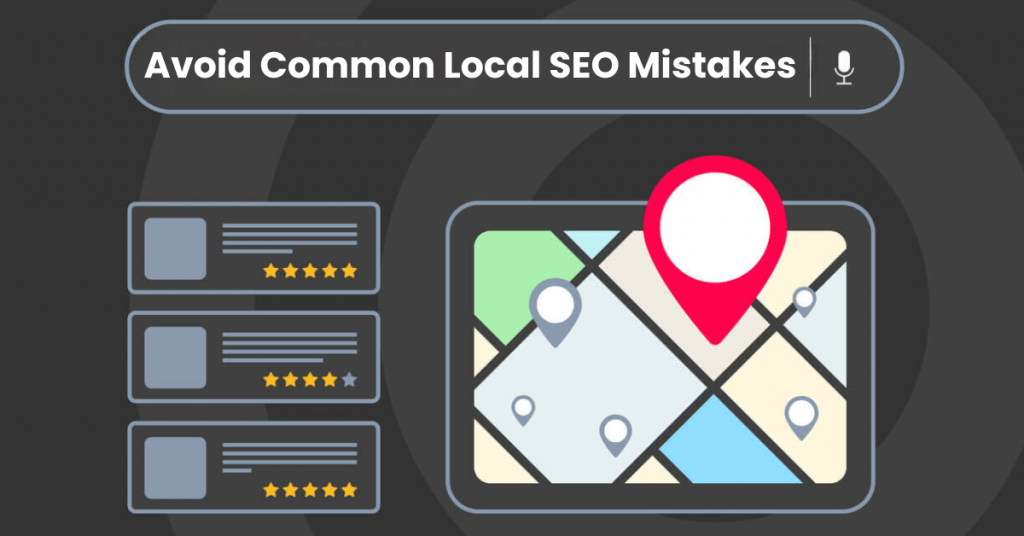
As a business owner, it’s important to understand the significance of local SEO in today’s digital landscape. With more consumers turning to the internet to find businesses in their area, local SEO has become a crucial component of any marketing strategy. Crafting a local SEO strategy such as optimising your website and online presence for local search, you can attract more customers and improve your search visibility.
Local SEO is the process of optimising your online presence to rank higher in local search results. This includes optimising your website, Google Business Profile listing, and other mentions of your business online for keywords related to your business and location. By doing so, you can increase your visibility in search engine results pages (SERPs) and make it easier for customers to find your business.
However, with constantly changing algorithms and best practices, it can be easy to make mistakes that can negatively impact your local SEO. See below for some of the most common local SEO mistakes to avoid to ensure your business is visible to the highest number of potential customers in your area.
Mistake #1: Not Claiming and Verifying Your Google Business Profile Listing
One of the most critical mistakes businesses make when it comes to local SEO is not claiming and verifying their Google Business Profile listing. This is a free profile that allows businesses to manage their presence on Google Search & Google Maps. Customers can receive important information about your business such as your hours of operation, contact information, and Google reviews.
However, simply creating a business profile is not enough and you must ensure it is accurate in search results by claiming and verifying the listing. By not claiming and verifying your business listing, you risk not having control of your business’ information online with potentially incorrect or outdated information appearing in search results. This can lead to confusion and mistrust among customers, making it less likely they will visit your business. See this Google Business Profile tips article for more information.
To avoid this mistake, make sure to claim and verify your GMB listing as soon as possible. You will then be prompted to verify your listing through a postcard sent to your business address. Once you have claimed and verified your listing, make sure to regularly update and maintain your listing with accurate and relevant information.
Mistake #2: Not Optimising Your Site for Local Keywords
Another common mistake businesses make is not optimising their website for local keywords. Local keywords are terms and phrases that include your city or region and are relevant to your business. For example, if you run a pizza restaurant in Brisbane, local keywords for your business might include “pizza delivery Brisbane” or “best pizza in Brisbane.”
By not optimising your website for local keywords, you risk missing out on potential customers who are searching for businesses like yours in their area. When search engines crawl your website, they use the content and keywords to determine what your business is about and where it’s located. It is important to complete keyword research about related business terms that customers actually search for.
Make sure to include local keywords in important areas of your website such as your meta tags, title tags, and body content. Also be sure to include up to date NAP (Name, Address, Phone Number) information in all the pages of your website and make sure that it’s consistent across all platforms.
Mistake #3: Not Having a Mobile-Friendly Website
It’s essential for businesses to have a mobile-friendly website. Mobile optimisation for SEO is vital as a large percentage of internet users access the web on their mobile devices. A mobile-friendly website is one that is easy to navigate and read on a smaller screen that is also optimised for touch-based interactions.
However, many businesses still make the mistake of not having a mobile-friendly website. A website that is not optimised for mobile can be difficult to navigate, slow to load, and may not display properly on smaller screens. This can lead to a poor user experience, which can ultimately result in a loss of potential customers. Additionally, Google has announced that it would be using mobile-first indexing which means it prioritises the mobile version of a website for indexing and ranking.
To avoid this mistake, make sure that your website is mobile-friendly by testing it on different devices and screen sizes. There are several online tools available, such as Google’s Mobile-Friendly Test, that can help you determine whether your website is mobile-friendly. You should also consider using a responsive web design, which allows your website to adapt to the screen size of the device being used to access it.
Mistake #4: Not Regularly Updating & Maintaining Your Online Presence
Once you have set up your website, Google Business Profile, and social media profiles, it’s important to regularly update and maintain them. This includes adding new content, responding to customer reviews, and ensuring all your critical business information is accurate and up-to-date.
Not maintaining a business’ online presence can lead to outdated information appearing on your website, social media profiles, and Google Business Profile listing. Outdated information can cause confusion and mistrust among customers and search engines. Ensure you don’t have duplicate listings online for your business across directory sites and make sure all information is consistent across every profile.
To avoid this mistake, make sure to regularly update and maintain your online presence. This includes adding new content, responding to customer reviews, and ensuring that your information is accurate and up-to-date. Keep an eye out for customer reviews and respond to them as soon as possible as this will help you build trust and credibility with your customers.

Mistake #5: Not Tracking and Analysing Your Local SEO Efforts
Once you have implemented your local SEO strategy, it’s important to track and analyse your progress over time. By regularly monitoring your local SEO efforts, you can identify areas that need improvement, and make adjustments to your strategy accordingly.
Failing to monitor local SEO can result in a limited understanding of how a business’ actions can affect their visibility in search results. If you don’t track and analyse, you run the risk of wasting time and resources on strategies that aren’t delivering optimal results and may miss out on opportunities to enhance your local SEO.
To avoid this mistake, make sure to set up tracking and analytics for your website and be sure to check the data relating to your Google Business Profile. There are several tools available, such as Google Analytics, that can help you track and analyse your local SEO efforts. Use these tools to monitor your website’s rankings on Google Maps and Google Search by looking at keyword and ranking data. You can also use Google Search Console to monitor your website’s performance on Google, which will provide more data on how your website is performing and help you identify issues that need to be addressed.
Mistake #6: Not Optimising Location Pages (If Necessary)
If your business serves multiple locations, it is essential to create a separate page for each location area on your website. This allows search engines and customers to easily find and access information about each of your locations. Many businesses make the mistake of not having a separate page for each location. Instead, they may list all of their locations on one page, making it difficult for search engines and customers to find the specific information they’re looking for.
Additionally, having a separate page for each location allows you to optimise the page for local keywords and include location-specific information, such as photos, online reviews, and maps. This can help improve the visibility of each location within local search results on search engines. Also make sure to optimise each page for local keywords and include your NAP information consistently across all pages.
Avoid Common Mistakes to Ensure Maximum Customer Reach
Local SEO has become an essential component of any marketing strategy in recent times. By optimising your website and online presence for local search, you can attract more customers and improve your search visibility. However, with the constantly changing algorithms and best practices, it can be easy to make mistakes that can negatively impact your local SEO.
By avoiding these common mistakes, you can ensure that your business is visible to potential customers in your area. Remember to regularly update and maintain your online presence, and make adjustments to your strategy as needed. With a solid local SEO strategy in place, your business can attract more customers, increase revenue, and grow its online presence.
It is best to deal with local SEO experts who regularly avoid these mistakes. Click the button below to get a free SEO audit of your site and see how engaging with an SEO agency can greatly benefit your business today!


